Assessment of Ecological Condition of Haplic Chernozem Calcic Contaminated with Petroleum Hydrocarbons during Application of Bioremediation Agents of Various Natures
Abstract
1. Introduction
2. Materials and Methods
3. Results and Discussion
3.1. Residual Petroleum Hydrocarbon Content in Petroleum Hydrocarbon-Contaminated Soil after Application of Bioremediation Agents
3.2. Change in the Number of Soil Bacteria of Non-Contaminated and Petroleum Hydrocarbon-Contaminated Haplic Chernozem Calcic after Application of Bioremediation Agents
3.3. Change in the Enzyme Activity of Non-Contaminated and Petroleum Hydrocarbon-Contaminated Haplic Chernozem Calcic after Application of Bioremediation Agents
3.4. Change in Soil Respiration of Non-Contaminated And Petroleum Hydrocarbon-Contaminated Haplic Chernozem Calcic after Application of Bioremediation Agents
3.5. Change in the Intensity of Initial Growth and Development of Radish Seeds in Non-Contaminated and Petroleum Hydrocarbon-Contaminated Haplic Chernozem Calcic after Application of Bioremediation Agents
3.6. Change in the Integral Index of the Soil Biological State for Non-Contaminated and Petroleum Hydrocarbon-Contaminated Haplic Chernozem Calcic after Application of Bioremediation Agents
3.7. Assessment of the Cost Efficiency for Bioremediation Agent Use in Petroleum Hydrocarbon-Contaminated Haplic Chernozem Calcic
4. Conclusions
Author Contributions
Funding
Data Availability Statement
Acknowledgments
Conflicts of Interest
References
- Available online: https://minenergo.gov.ru/node/1209 (accessed on 5 February 2021).
- Available online: https://neftegaz.ru (accessed on 5 February 2021).
- Minnikova, T.V.; Denisova, T.V.; Mandzhieva, S.S.; Kolesnikov, S.I.; Minkina, T.M.; Chaplygin, V.A.; Burachevskaya, M.V.; Sushkova, S.N.; Bauer, T.V. Assessing the effect of heavy metals from the Novocherkassk power station emissions on the biological activity of soils in the adjacent areas. J. Geochem. Explor. 2017, 174, 70–78. [Google Scholar] [CrossRef]
- Polyak, Y.M.; Bakina, L.G.; Chugunova, M.V.; Mayachkina, N.V.; Gerasimov, A.O.; Bure, V.M. Effect of remediation strategies on biological activity of oil-contaminated soil—A field study. Int. Biodeterior. Biodegrad. 2018, 126, 57–68. [Google Scholar] [CrossRef]
- Khudur, L.S.; Shahsavari, E.; Webster, G.T.; Nugegoda, D.; Ball, A.S. The impact of lead co-contamination on ecotoxicity and the bacterial community during the bioremediation of total petroleum hydrocarbon-contaminated soils. Environ. Pollut. 2019, 253, 939–948. [Google Scholar] [CrossRef] [PubMed]
- Gomes, L.; Simoes, S.J.C.; Dalla Nora, E.L.; de Sousa-Neto, E.R.; Forti, M.C.; Ometto, J.P.H.B. Agricultural expansion in the Brazilian Cerrado: Increased soil and nutrient losses and decreased agricultural productivity. Land 2019, 8, 12. [Google Scholar] [CrossRef]
- Alipbeki, O.; Alipbekova, C.; Sterenharz, A.; Toleubekova, Z.; Makenova, S.; Aliyev, M.; Mineyev, N. Analysis of land-use change in shortandy district in terms of sustainable development. Land 2020, 9, 147. [Google Scholar] [CrossRef]
- Poi, G.; Shahsavari, E.; Aburto-Medina, A.; Mok, P.C.; Ball, A.S. Large scale treatment of total petroleum-hydrocarbon contaminated groundwater using bioaugmentation. J. Environ. Manag. 2018, 214, 157–163. [Google Scholar] [CrossRef]
- Li, X.; Song, Y.; Yao, S.; Bian, Y.; Gu, C.; Yang, X.; Wang, F.; Jiang, X. Can biochar and oxalic acid alleviate the toxicity stress caused by polycyclic aromatic hydrocarbons in soil microbial communities? Sci. Total Environ. 2019, 695, 133879. [Google Scholar] [CrossRef] [PubMed]
- Minnikova, T.V.; Lubentsova, D.V.; Kolesnikov, S.I.; Kazeev, K.S. AgroEkoInfo. 1. Influence of Sanitation with Humic Substances on the Biological State of Oil-Contaminated Chernozems. 2020. Available online: http://agroecoinfo.narod.ru/journal/STATYI/2020/1/st_111.doc (accessed on 5 February 2021).
- Souza, E.C.; Vessoni-Penna, T.C.; de Souza Oliveira, R.P. Biosurfactant enhanced hydrocarbon bioremediation: An overview. Int. Biodeterior. Biodegrad. 2014, 89, 88–94. [Google Scholar] [CrossRef]
- Silvania, L.; Di Palma, P.R.; Riccardi, C.; Eek, E.; Hale, S.E.; Viottia, P.; Petrangeli, P.M. Use of biochar as alternative sorbent for the active capping of oil contaminated sediments. J. Environ. Chem. Eng. 2017, 5, 5241–5249. [Google Scholar] [CrossRef]
- Zhang, C.; Zeng, G.; Huang, D.; Lai, C.; Wang, R. Biochar for environmental management: Mitigating greenhouse gas emissions, contaminant treatment, and potential negative impacts. Chem. Eng. J. 2019, 3731, 902–922. [Google Scholar] [CrossRef]
- Yuan, P.; Wang, J.; Pan, Y.; Shen, B.; Wu, C. Review of biochar for the management of contaminated soil: Preparation, application and prospect. Sci. Total Environ. 2019, 6591, 473–490. [Google Scholar] [CrossRef]
- Wei, Z.; Wang, J.J.; Meng, Y.; Li, J.; DeLaune, R.D. Potential use of biochar and rhamnolipid biosurfactant for remediation of crude oil-contaminated coastal wetland soil: Ecotoxicity assessment. Chemosphere 2020, 253, 126617. [Google Scholar] [CrossRef]
- Chagas-Spinelli, A.C.O.; Kato, M.T.; de Lima, E.S.; Gavazza, S. Bioremediation of a tropical clay soil contaminated with diesel oil. J. Environ. Manag. 2012, 113, 510–516. [Google Scholar] [CrossRef]
- Wawra, A.; Friesl-Hanl, W.; Puschenreiter, M.; Soja, G.; Reichenauer, T.; Roithner, C.; Watzinger, A. Degradation of polycyclic aromatic hydrocarbons in a mixed contaminated soil supported by phytostabilisation, organic and inorganic soil additives. Sci. Total Environ. 2018, 628, 1287–1295. [Google Scholar] [CrossRef]
- Myazin, V.A. Dynamics of the content of organic carbon and water-soluble phosphates in the soil during the cleaning and restoration of oil-contaminated territories. Vestnik MGTU 2019, 22, 90–100. [Google Scholar] [CrossRef]
- Varjani, S.J.; Upasani, V.N. A new look on factors affecting microbial degradation of petroleum hydrocarbon pollutants. Int. Biodeterior. Biodegrad. 2017, 120, 71–83. [Google Scholar] [CrossRef]
- Alvimn, G.M.; Pontes, P.P. Aeration and sawdust application effects as structural material in the bioremediation of clayey acid soils contaminated with diesel oil. Int. Soil Water Conserv. Res. 2018, 6, 253–260. [Google Scholar] [CrossRef]
- Guerra, A.B.; Oliveira, J.S.; Silva-Portela, R.C.B.; Araújo, W.; Carlos, A.C.; Vasconcelos, A.T.R.; Freitas, A.T.; Domingos, Y.S.; Ferreira de Farias, M.; Fernandes, J.T.G.; et al. Metagenome enrichment approach used for selection of oil-degrading bacteria consortia for drill cutting residue bioremediation. Environ. Pollut. 2018, 235, 869–880. [Google Scholar] [CrossRef] [PubMed]
- Igun, O.T.; Meynet, P.; Davenport, R.J.; Werner, D. Impacts of activated carbon amendments, added from the start or after five months, on the microbiology and outcomes of crude oil bioremediation in soil. Int. Biodeterior. Biodegrad. 2019, 142, 1–10. [Google Scholar] [CrossRef]
- Khoshkholgh, S.N.A.; Ebadi, A.; Reiahisamani, N.; Rasekh, B. Bio-based remediation of petroleum-contaminated saline soils: Challenges, the current state-of-the-art and future prospects. J. Environ. Manag. 2019, 250, 109476. [Google Scholar] [CrossRef]
- Varjani, S.; Upasani, V.N. Influence of abiotic factors, natural attenuation, bioaugmentation and nutrient supplementation on bioremediation of petroleum crude contaminated agricultural soil. J. Environ. Manag. 2019, 245, 358–366. [Google Scholar] [CrossRef]
- Achuba, F.I.; Peretiemo-Clarke, B.O. Effect of spent engine oil on soil catalase and dehydrogenase activities. Agrophysics 2008, 22, 1–4. [Google Scholar]
- Dindar, E.; Şağban, F.O.T.; Başkaya, H.S. Variations of soil enzyme activities in petroleum-hydrocarbon contaminated soil. Int. Biodeterior. Biodegrad. 2015, 105, 268–275. [Google Scholar] [CrossRef]
- Grigorieva, T.V.; Laikov, A.V.; Rizvanov, A.A.; Ilinskaya, O.N.; Naumova, R.P. The composition of the microbial community of oil sludge based on the analysis of the 16S rRNA gene. Microbiology 2013, 82, 635–639. [Google Scholar]
- Galiulin, R.V.; Galiulina, R.A.; Bashkin, V.N.; Akopova, G.S.; Listov, E.L.; Balakirev, I.V. Comparative assessment of the decomposition of hydrocarbons of gas condensate and oil in the soil under the influence of biological agents. Agrochemistry 2010, 10, 52–58. [Google Scholar]
- Ivshina, I.B.; Krivoruchko, A.V.; Kuyukina, M.S.; Kostina, L.V.; Peshkur, T.A.; Cunningham, K.D. Bioremediation of soils disturbed by hydrocarbons and heavy metals using Rhodococcus-biosurfactants and immobilized rhodococci. Agrar. Bull. Urals 2012, 8, 65–68. [Google Scholar]
- Demidenko, G.A.; Nedelin, N.A.; Fomina, N.V. Reclamation of technogenically polluted landscape using the biological product “Tamir”. Bulletin of KrasGAU 2014, 10, 126–131. [Google Scholar]
- Wu, M.; Dick, W.A.; Li, W.; Wang, X.; Yang, Q.; Wang, T.; Xu, L.; Zhang, M.; Chen, L. Bioaugmentation and biostimulation of hydrocarbon degradation and the microbial community in a petroleum-contaminated soil. Int. Biodeterior. Biodegrad. 2016, 107, 158–164. [Google Scholar] [CrossRef]
- Shamraev, A.V.; Shorina, T.S. Influence of oil and oil products on various components of the environment. Vest. OSU 2009, 6, 642–645. [Google Scholar]
- Macaulay, B.M.; Rees, D. Bioremediation of oil spills: A review of challenges for research advancement. Annu. Environ. Sci. 2014, 8, 2. [Google Scholar]
- Suleimanov, R.R.; Abdrakhmanov, T.A.; Zhabbarov, Z.A.; Tursunov, L.T. Enzymatic activity and agrochemical properties of meadow-alluvial soil under conditions of oil pollution. Sam. Luka. 2007, 16, 575–580. [Google Scholar]
- Kolesnikov, S.I.; Aznauryan, D.K.; Kazeev, K.S.; Denisova, T.V. Study of the possibility of using urea and phosphogypsum as ameliorants in oil-contaminated soils in a model experiment. Agrochemistry 2011, 9, 77–81. [Google Scholar]
- Minnikova, T.V.; Denisova, T.V.; Kolesnikov, S.I.; Akimenko, Y.V. Assessment of agroecological indicators of oil-contaminated chernozem of Rostov region during remediation with urea and potassium humate. Russ. Agric. Sci. 2018, 1, 44–48. [Google Scholar]
- Isakova, E.A. Features of the impact of oil and oil products on soil biota. Coll. J. 2019, 12, 7–10. [Google Scholar]
- Kabirov, R.R.; Kireeva, N.A.; Kabirov, T.R.; Dubovik, I.E.; Yakupova, A.B.; Safiullina, L.M. Assessment of the biological activity of oil-contaminated soils using an integral indicator. Eur. Soil Sci. 2012, 2, 184. [Google Scholar]
- Minnikova, T.V.; Kolesnikov, S.I.; Denisova, T.V. Influence of nitrogen and humic fertilizers on the biochemical state of oil-contaminated chernozem. S. Russ. Ecol. Dev. 2019, 14, 189–201. [Google Scholar] [CrossRef]
- Minnikova, T.V.; Kolesnikov, S.I.; Kazeev, K.S. Impact of ameliorants on the biological condition of oil-contaminated black soil. Soil Environ. 2019, 38, 170–180. [Google Scholar]
- Kolesnikov, S.I.; Rotina, E.N.; Kazeev, K.S. Evaluation of the effectiveness of reclamation of lands contaminated with fuel oil by biological indicators. Environ. Prot. Oil Gas Complex 2012, 2, 30–37. [Google Scholar]
- Kolesnikov, S.I.; Myasnikova, M.A.; Minnikova, T.V.; Ter-Misakyants, T.A.; Kazeev, K.S.; Akimenko, Y.V. Assessment of meadow soil resistance of the Azov sea region to pollution with heavy metals and oil. Ecol. Environ. Conserv. 2017, 23, 2346–2351. [Google Scholar]
- Daud, R.M.; Kolesnikov, S.I.; Kuzina, A.A.; Kazeev, K.S.; Akimenko, Y.V. Development of regional maximum permissible oil concentrations in the soils of arid ecosystems in southern Russia. Ecol. Ind. Russ. 2019, 23, 66–70. [Google Scholar] [CrossRef]
- Martynova, M.I.; Dzhansuzyan, R.R.; Zemlyanskaya, E.A.; Tarabanova, T.V.; Pligin, A.S. Features of the relief of the territory of the botanical garden of the southern federal university and its anthropogenic transformation. Proc. Univ. N. Cauc. Reg. Nat. Sci. 2009, 1, 122–125. [Google Scholar]
- Chupina, V.I. Anthropogenic soils of botanical gardens: A review. Eurasian Soil Sci. 2020, 53, 523–533. [Google Scholar] [CrossRef]
- Andronov, S.A.; Bykov, V.I. Glauconite is a mineral of the future. In Material 1st International Conference the importance of Industrial Minerals in the World Economy: Deposits, Technology Economic Assessment; GEOS: Moscow, Russia, 2006; pp. 79–83. [Google Scholar]
- Available online: https://ru.khumic.com (accessed on 5 February 2021).
- PND F 16.1: 2.2.22-98. Quantitative Chemical Analysis of Soils. Methods for Measuring the Mass Fraction of Petroleum Products in Mineral, Organogenic, Organomineral Soils and Bottom Sediments by IR Spectrometry. Available online: https://www.russiangost.com/p-162437-pnd-f-1612222-98.aspx (accessed on 5 February 2021).
- Kadulin, M.S.; Smirnova, I.E.; Koptsyk, G.N. The emission of carbon dioxide from soils of the pasvik nature reserve in the Kola subarctic. Eurasian Soil Sci. 2017, 50, 1055–1068. [Google Scholar] [CrossRef]
- Galstyan, A.S. Unification of methods for studying the activity of soil enzymes. Eur. Soil Sci. 1978, 2, 107–114. [Google Scholar]
- Khaziev, F.K. Methods of Soil Enzymology; Increased. acad. Science, Ufa’s Scientific Center, Institute of Biology; Nauka: Moscow, Russia, 2005; p. 252. [Google Scholar]
- Kazeev, K.S.; Kolesnikov, S.I.; Akimenko, Y.V.; Dadenko, E.V. Biodiagnostic Methods of Terrestrial Ecosystems; SFU Publishing House: Rostov-on-Don, Russia, 2016; p. 356. [Google Scholar]
- Zvyagintsev, D.G. Methods of Soil Microbiology and Biochemistry; Moscow State University Publishing House: Moscow, Russia, 1991; p. 304. [Google Scholar]
- Kolesnikov, S.I.; Kazeev, K.S.; Valkov, V.F. Environmental Consequences of Soil Pollution with Heavy Metals; Publishing house SKNTs VSh: Rostov-on-Don, Russia, 2000; p. 232. [Google Scholar]
- Doumer, M.E.; Rigol, A.; Vidal, M.; Mangrich, A.S. Removal of Cd, Cu, Pb, and Zn from aqueous solutions by biochars. Environ. Sci. Pollut. Res. 2016, 23, 2684–2692. [Google Scholar] [CrossRef] [PubMed]
- Yagafarova, G.G.; Leontyeva, S.V.; Safarov, A.K.; Fedorova, Y.A.; Zainutdinova, E.M. Features of the process of activation of aboriginal microflora for cleaning the soil from ecotoxicants. Bull. Technol. Univ. 2016, 19, 205–207. [Google Scholar]
- Carrier, M.; Hardie, A.G.; Uras, Ü.; Görgens, J.; Knoetze, J.H. Production of char from vacuum pyrolysis of South-African sugar cane bagasse and its characterization as activated carbon and biochar. J. Anal. Appl. Pyrolysis 2012, 96, 24–32. [Google Scholar] [CrossRef]
- Sweeney, D.W.; Pierzynski, G.M.; Barnes, P.L. Nutrient losses in field-scale surface runoff from claypan soil receiving turkey litter and fertilizer. Agric. Ecosyst. Environ. 2012, 15015, 19–26. [Google Scholar] [CrossRef]
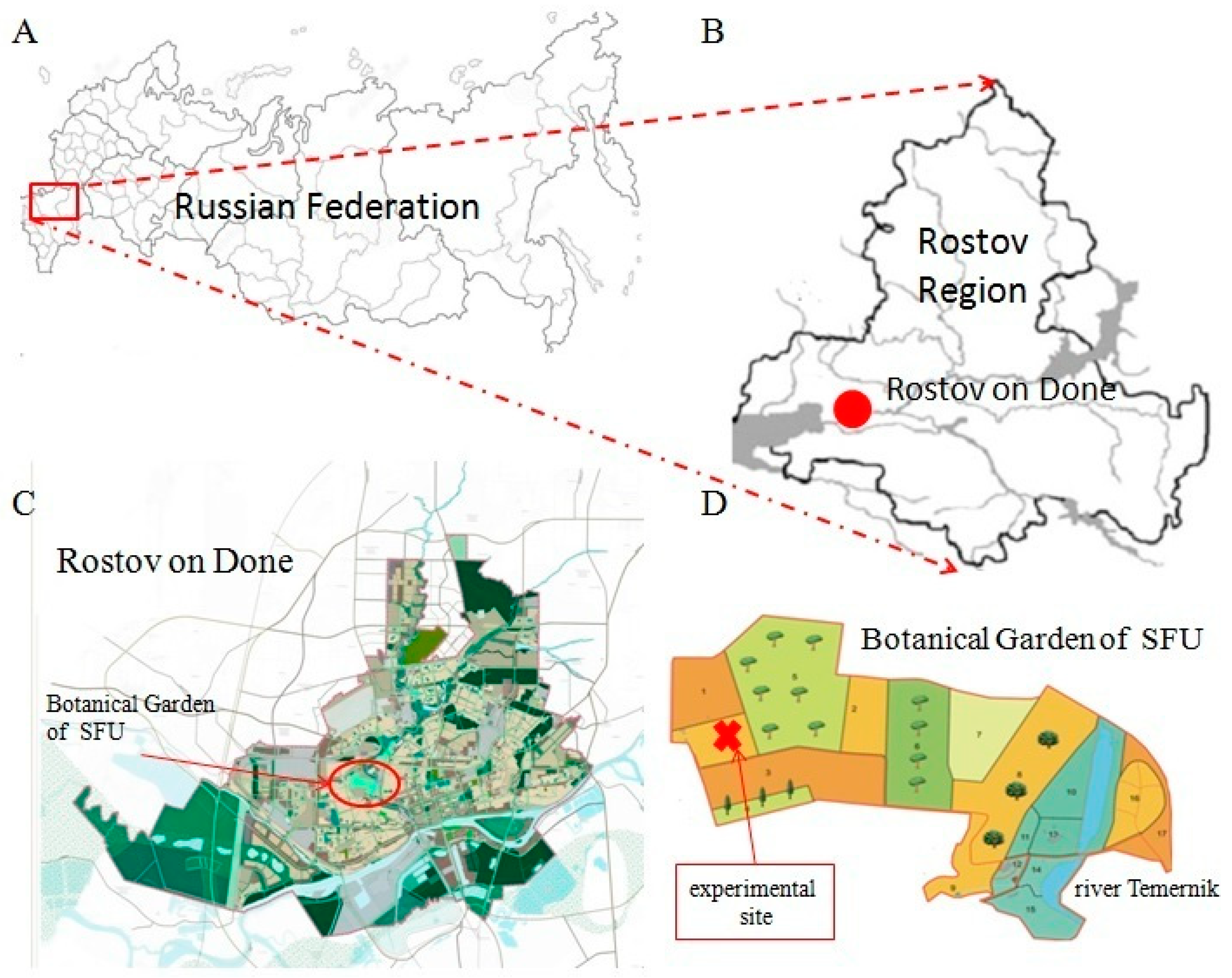
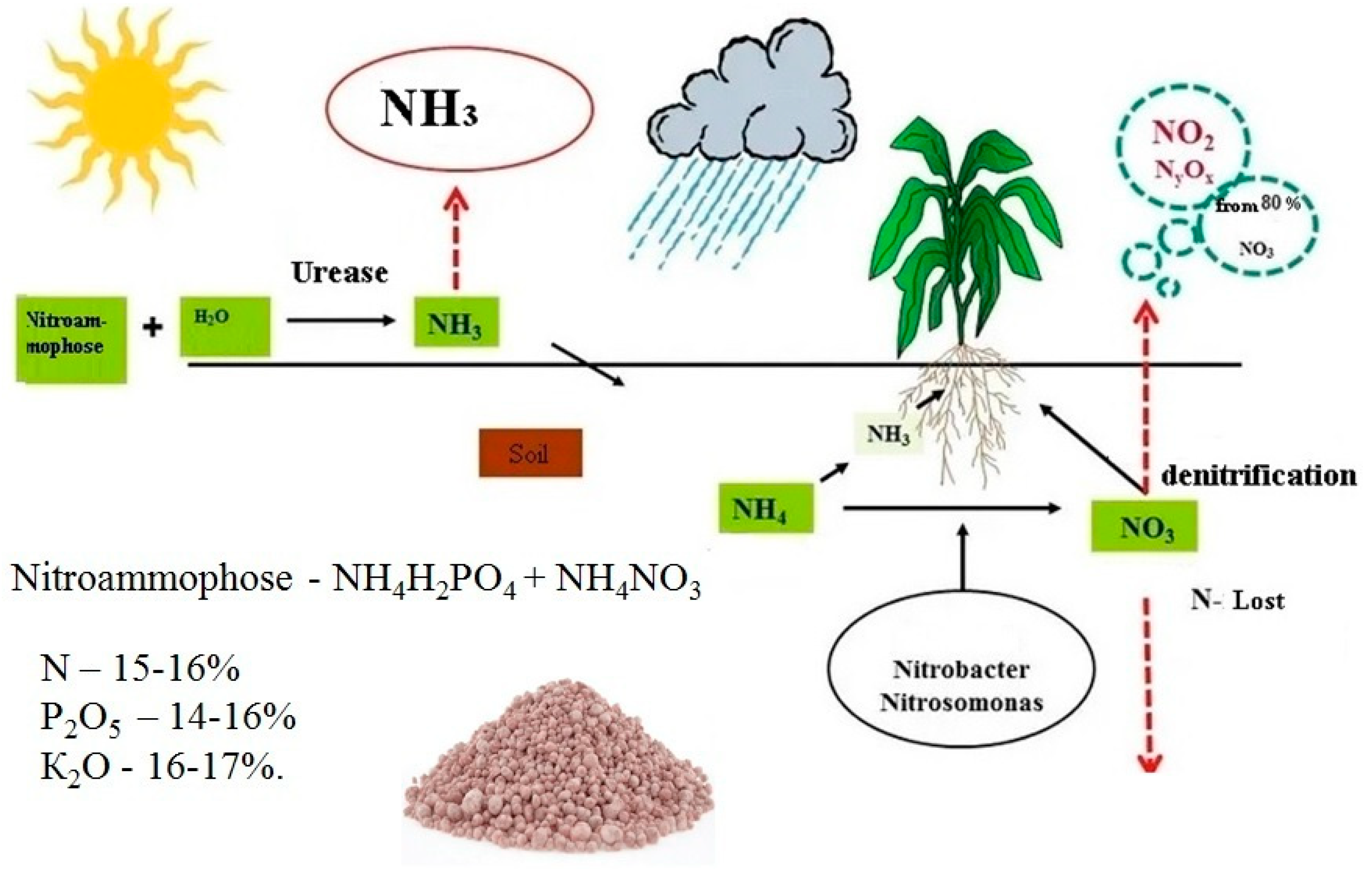


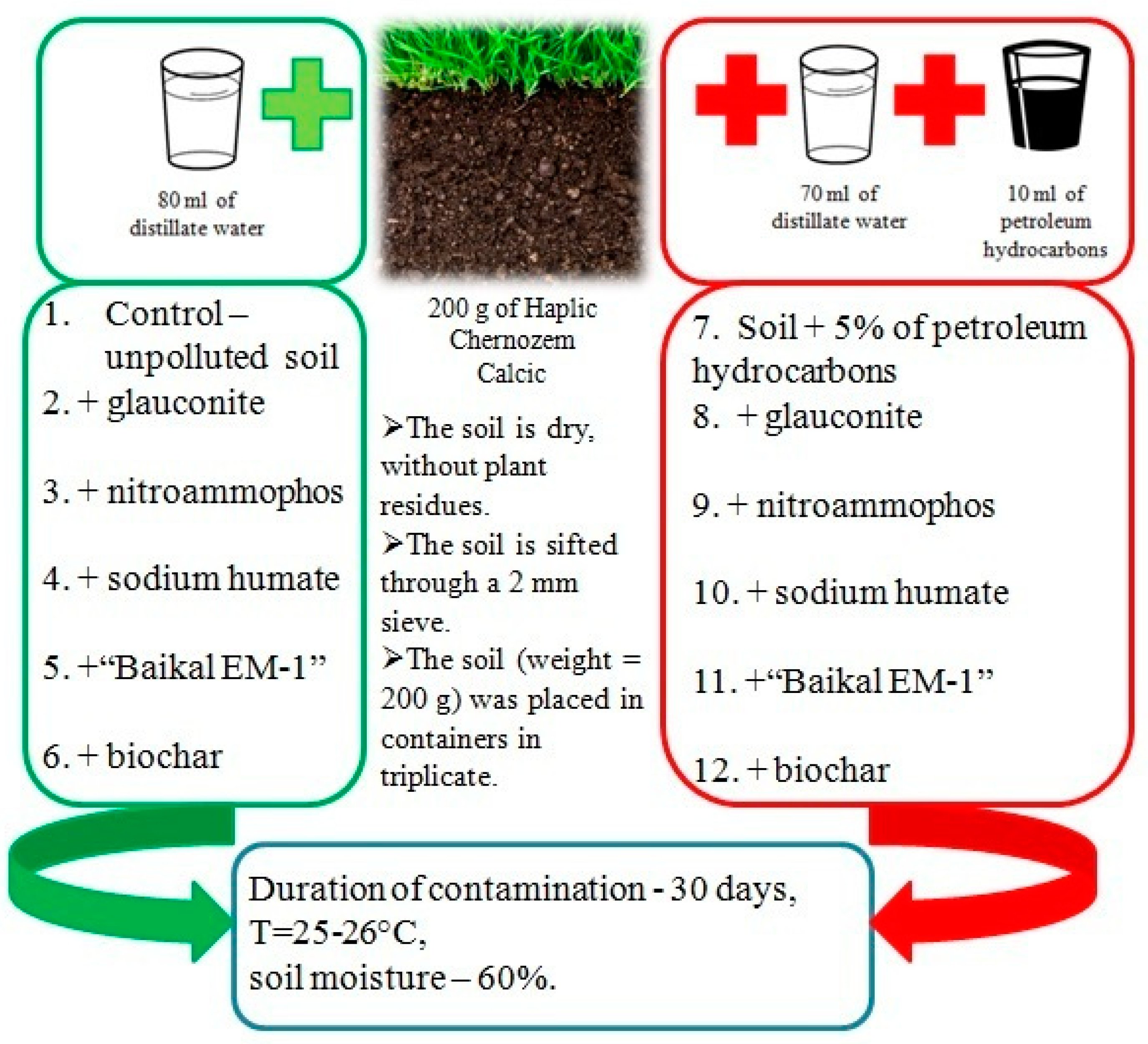

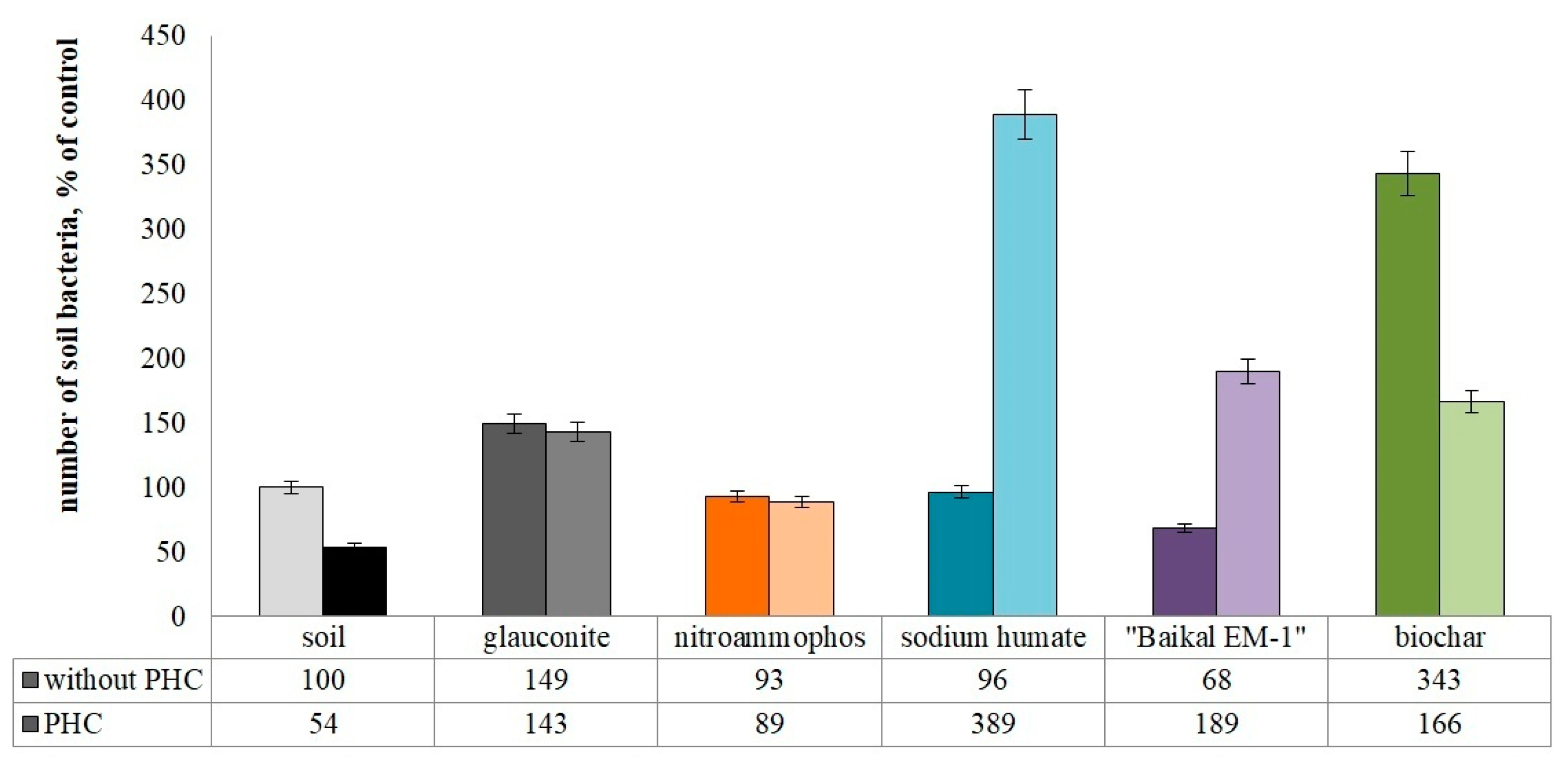
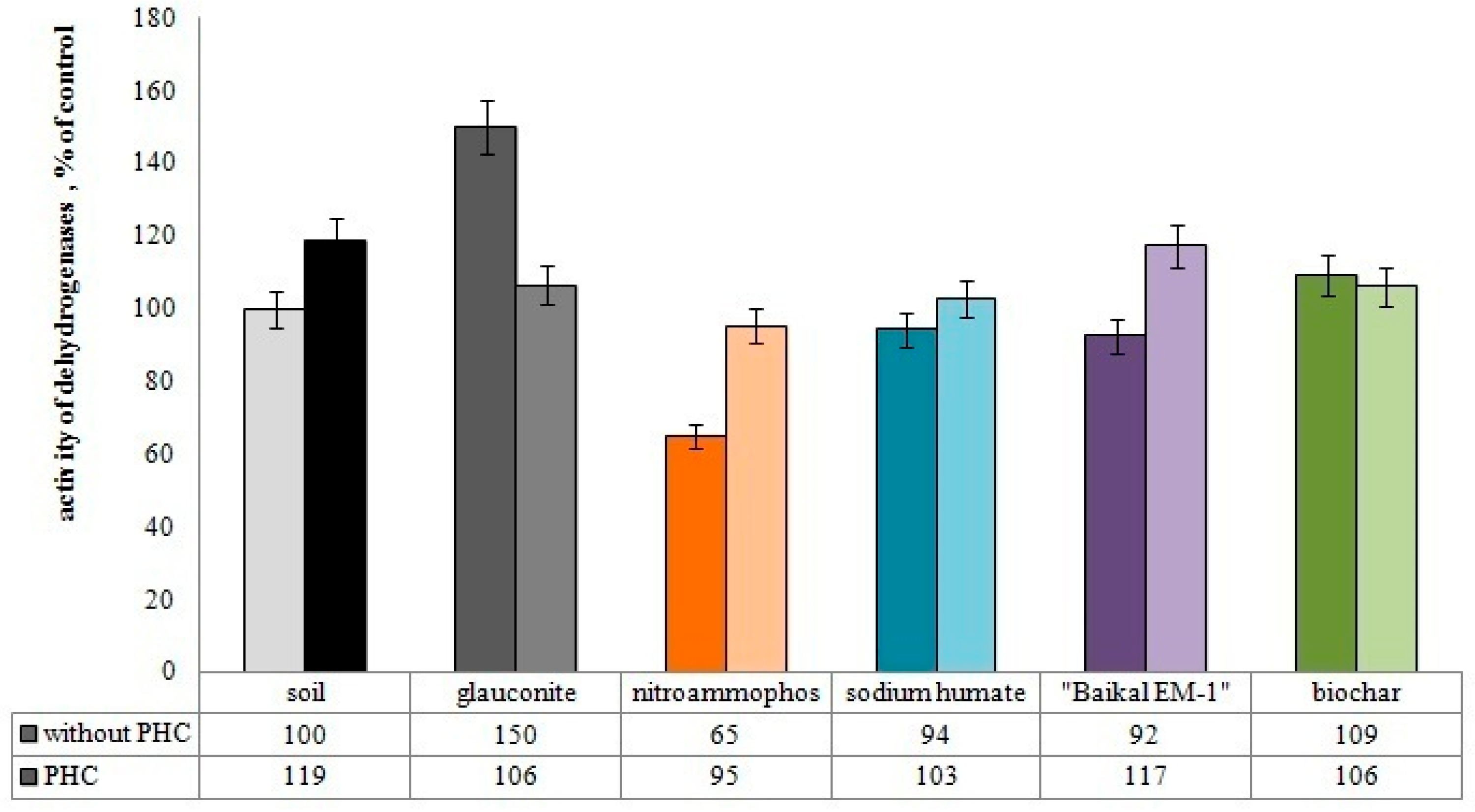
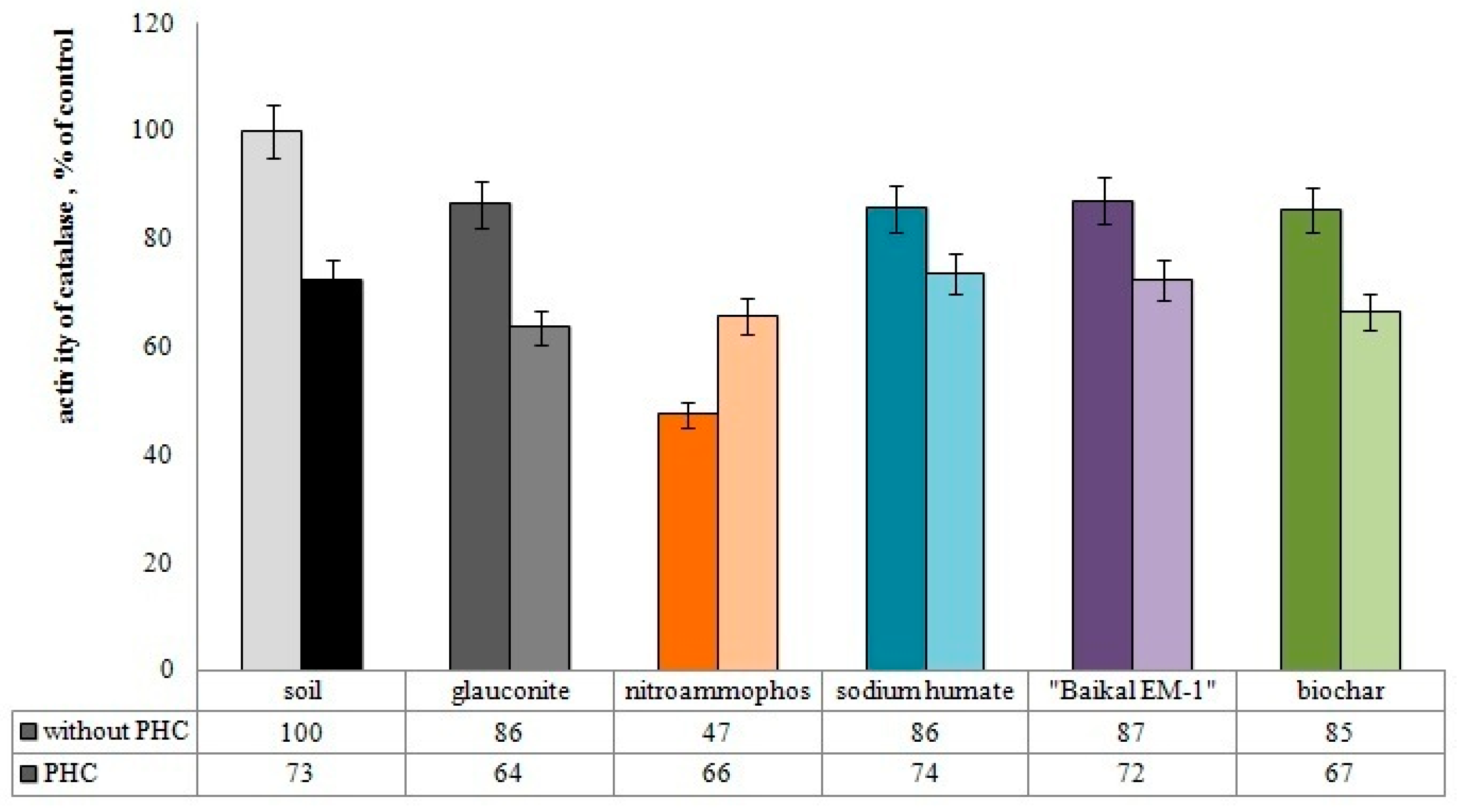
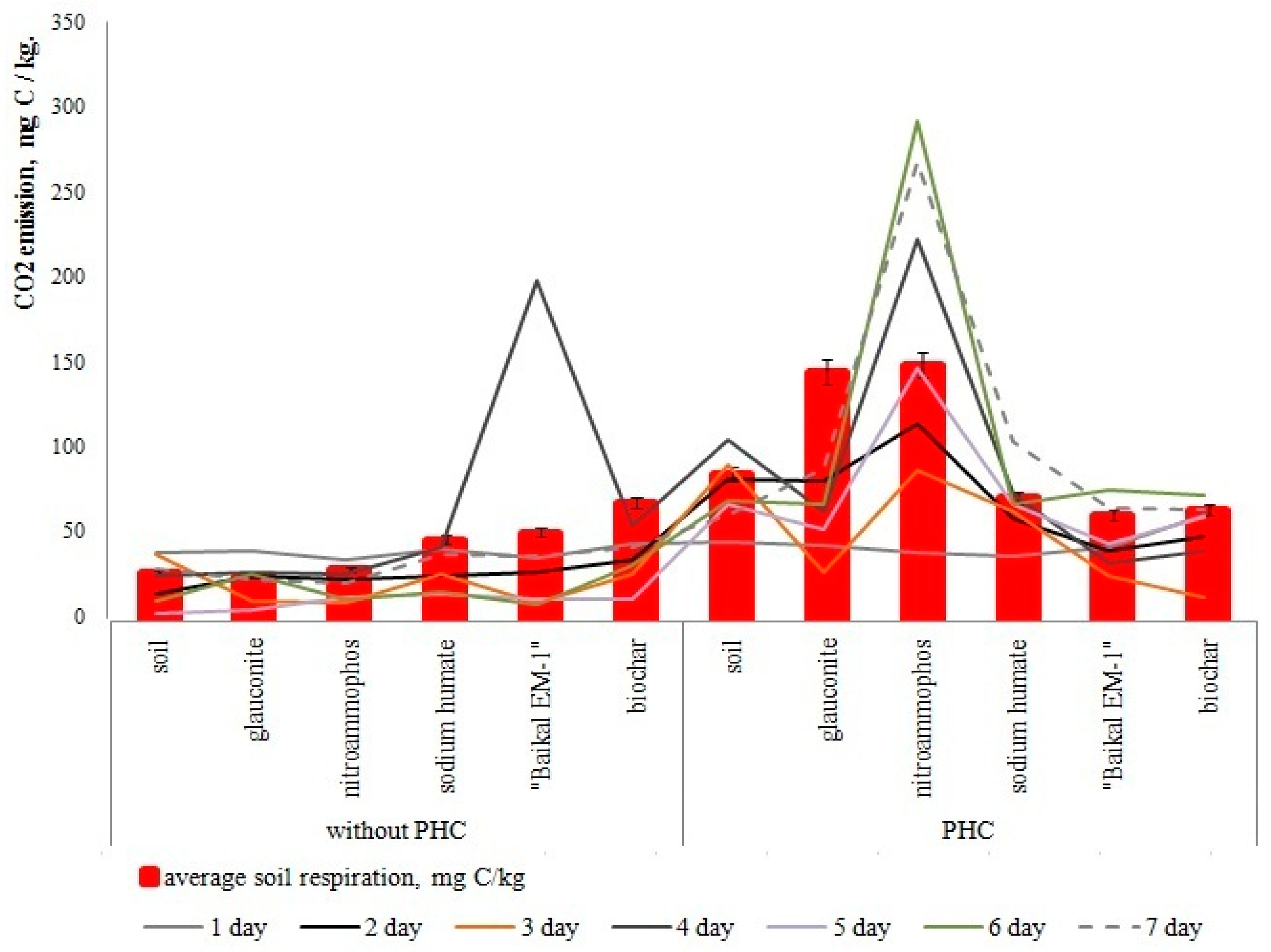
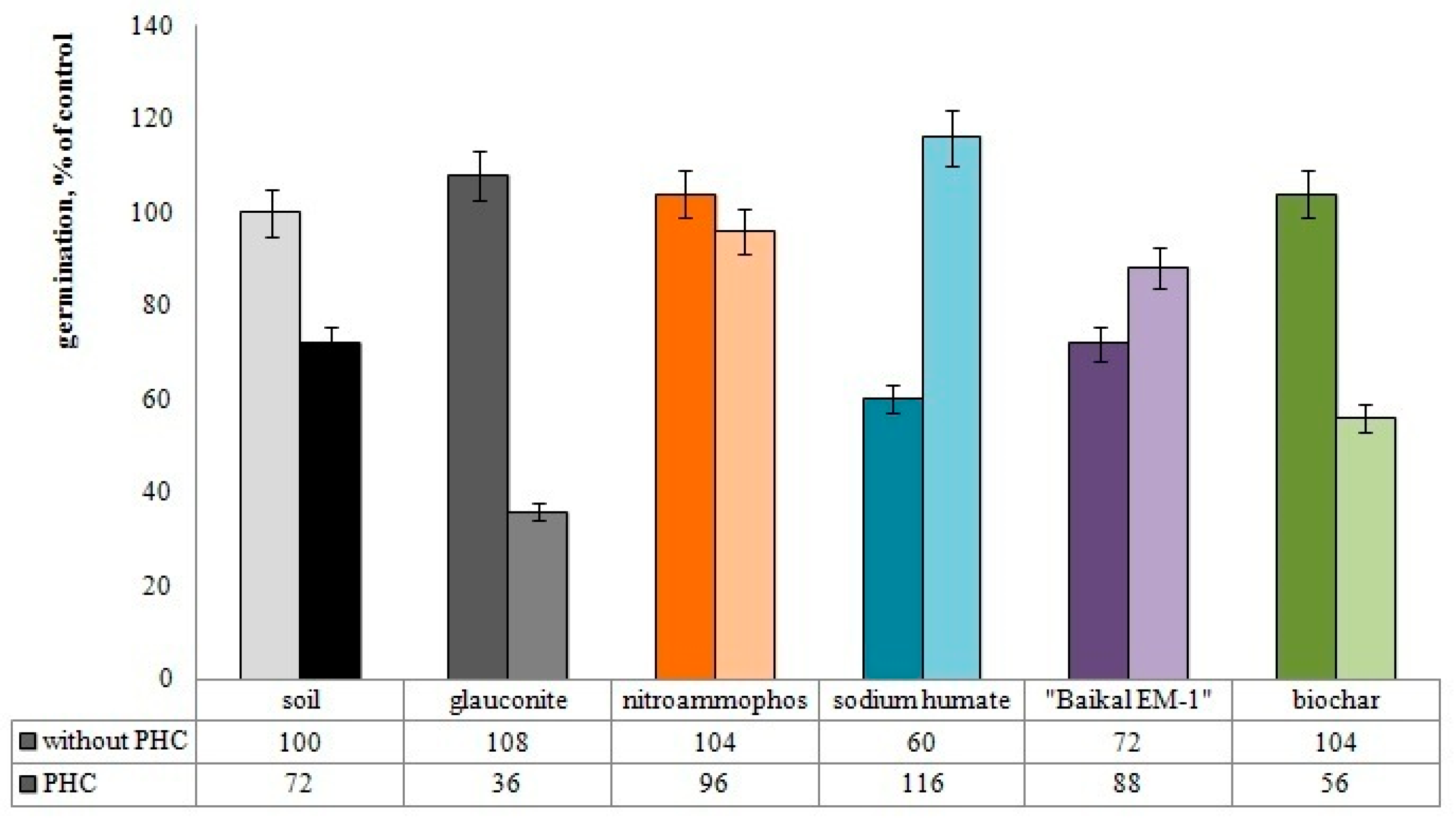
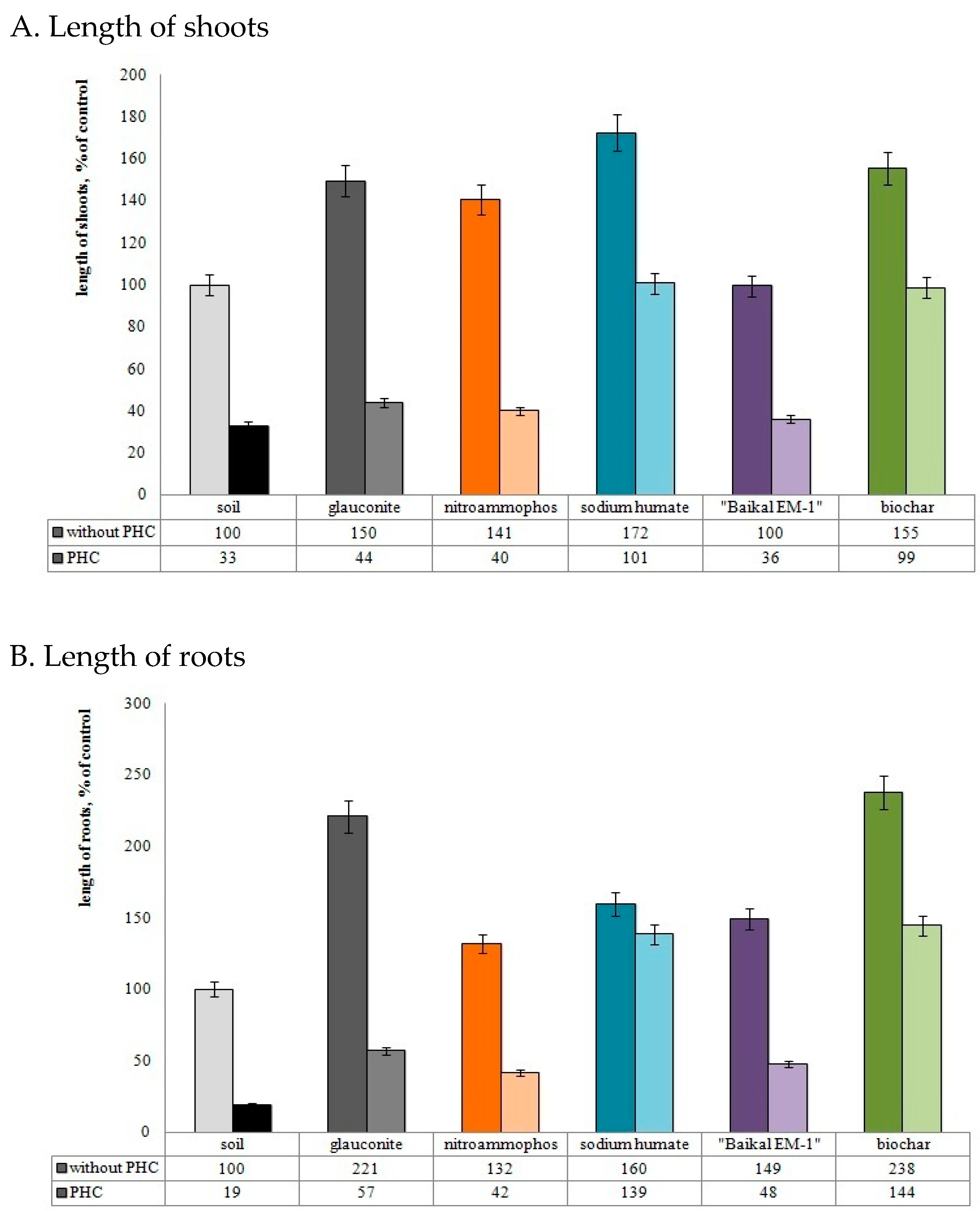
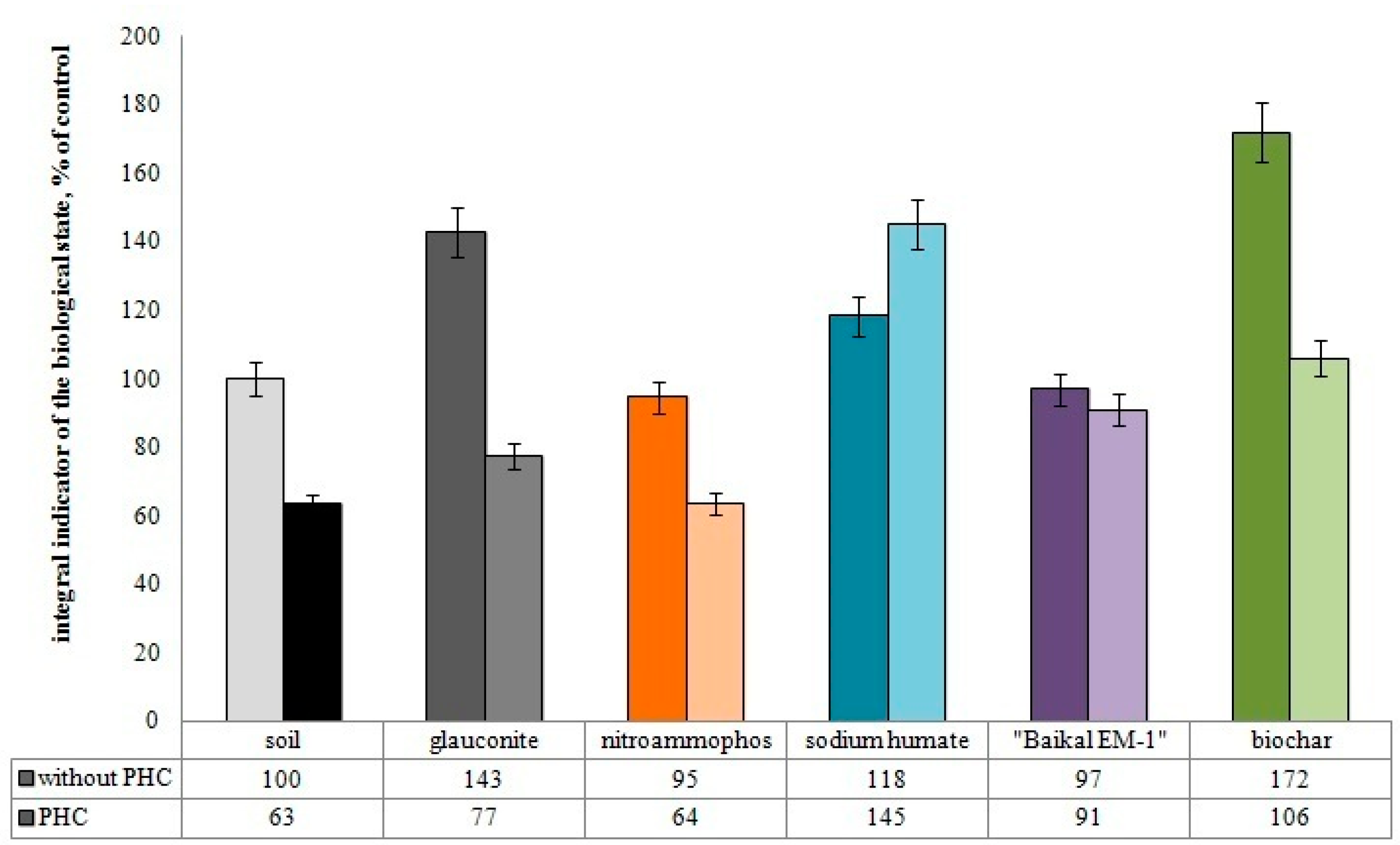
| No. | Characteristic | Unit | Value |
|---|---|---|---|
| 1. | Bulk density | kg/m3 | 1300–1400 |
| 2. | Specific surface | m2·g | 180–200 |
| 3. | Intergranular porosity | % | 60–72 |
| 4. | Petroleum product capacity | mg/g | 200–220 |
| 5. | Phenol capacity | mg/g | 1000 |
| Distribution ratio: | |||
| 6. | by Sr90 | mL/g | 214 |
| 7. | by Cs137 | mL/g | 2.6·103 |
| 8. | Fractional composition | mm | 0.1–0.6 |
| Characteristics | Value |
|---|---|
| Humic acid salts | 84.0–86.0 |
| Silicon, Si water-soluble. | 4.0–5.0 |
| Carbon, C | 46.0–49.0 |
| Oxygen, O | 17.0–19.0 |
| Hydrogen, H | 3.0–4.0 |
| Nitrogen, N | 0.8–1.0 |
| Phosphorus, P | 0.5–0.7 |
| Potassium, K | 6.0–8.0 |
| Sulfur, S | 0.75 |
| Calcium, Ca | 1.0–2.0 |
| Magnesium, Mg | 0.15 |
| Sodium, Na | 3.0–5.0 |
| Silicon, Si | 9.0–10.0 |
| Iron, Fe | 0.4–0.5 |
| Manganese, Mn | 0.12 |
| Molybdenum, Mo | 0.02 |
| Cobalt, Co | 0.02 |
| Zinc, Zn | 0.30 |
| Boron, B | 0.30 |
| Copper, Cu | 0.20 |
| No. | Type of Bioremediator |
|---|---|
| 1 | Control |
| 2 | C + glauconite |
| 3 | C + nitroammophos |
| 4 | C + sodium humate |
| 5 | C + Baikal EM-1 |
| 6 | C + biochar |
| 7 | petroleum hydrocarbons (5% of soil)—PHC |
| 8 | PHC + glauconite |
| 9 | PHC + nitroammophos |
| 10 | PHC + sodium humate |
| 11 | PHC + “Baikal EM-1” |
| 12 | PHC + biochar |
| No. | Type of Bioremediator | Appearance | C 1 | CBR 2 |
|---|---|---|---|---|
| 1. | Glauconite | Gray fine powder | 3.7 3 | 16,600 |
| 2. | Nitroammophos | Gray-white solid opaque crystals | 5.2 | 300 |
| 3. | Sodium humate | Dark brown viscous paste | 4.5 | 200 |
| 4. | “Baikal EM-1” | Dark brown liquid | 7.5 | 2 |
| 5. | Biochar | Black coal coarse powder | 7.5 | 11 |
| No. | Type of Bioremediators | DPCH | C | CBR | E |
|---|---|---|---|---|---|
| 1. | Glauconite | 0.51 | 16,600 | 3.75 | 31,996 |
| 2. | Nitroammophos | 0.50 | 200 | 5.25 | 527 |
| 3. | Sodium humate | 0.50 | 200 | 4.50 | 446 |
| 4. | “Baikal EM-1" | 0.49 | 30 | 7.50 | 110 |
| 5. | Biochar | 0.57 | 200 | 7.50 | 847 |
Publisher’s Note: MDPI stays neutral with regard to jurisdictional claims in published maps and institutional affiliations. |
© 2021 by the authors. Licensee MDPI, Basel, Switzerland. This article is an open access article distributed under the terms and conditions of the Creative Commons Attribution (CC BY) license (http://creativecommons.org/licenses/by/4.0/).
Share and Cite
Minnikova, T.; Kolesnikov, S.; Minkina, T.; Mandzhieva, S. Assessment of Ecological Condition of Haplic Chernozem Calcic Contaminated with Petroleum Hydrocarbons during Application of Bioremediation Agents of Various Natures. Land 2021, 10, 169. https://doi.org/10.3390/land10020169
Minnikova T, Kolesnikov S, Minkina T, Mandzhieva S. Assessment of Ecological Condition of Haplic Chernozem Calcic Contaminated with Petroleum Hydrocarbons during Application of Bioremediation Agents of Various Natures. Land. 2021; 10(2):169. https://doi.org/10.3390/land10020169
Chicago/Turabian StyleMinnikova, Tatiana, Sergey Kolesnikov, Tatiana Minkina, and Saglara Mandzhieva. 2021. "Assessment of Ecological Condition of Haplic Chernozem Calcic Contaminated with Petroleum Hydrocarbons during Application of Bioremediation Agents of Various Natures" Land 10, no. 2: 169. https://doi.org/10.3390/land10020169
APA StyleMinnikova, T., Kolesnikov, S., Minkina, T., & Mandzhieva, S. (2021). Assessment of Ecological Condition of Haplic Chernozem Calcic Contaminated with Petroleum Hydrocarbons during Application of Bioremediation Agents of Various Natures. Land, 10(2), 169. https://doi.org/10.3390/land10020169









